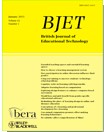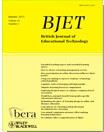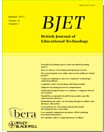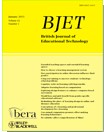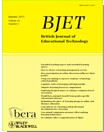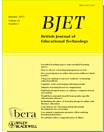-
基础教育
- 教材:
-
- 全部
- 中国地图出版社
- 人教版
- 人教版2012
- 人教版2013版
- 人教版PEP(3年级)
- 人教版义务
- 人教版新课标
- 人教版新起点(1年级)
- 人教版(Go for it)
- 人教版(三年级起点)
- 人教版(三年级起点)2012-2013
- 人教版(版本不明)
- 人教社2016年新编教材
- 冀教版
- 冀教版(三年级起点)
- 北京版
- 北师大版
- 北师大版(2016)
- 北师大版(1年级)
- 北师大版(3年级)
- 北师版2013
- 华东师大版
- 外研社版
- 外研社(三年级起点)
- 外研社(广西专用)
- 广州新版(三年级起点)
- 广州版
- 开心学英语
- 教育科学(3年级起点)
- 教育科学(广州版)
- 新华东师大版
- 新起点英语
- 朗文英语
- 河北版
- 湘少版(3年级起点)
- 牛津上海版
- 牛津上海版(深圳新版)
- 牛津英语
- 粤教版
- 苏教版
- 语文S版
- 语文版
- 首师大版
- 香港现代版
- 齐齐学英语
- 高等教育
- 职业教育
-
The future for (second) life and learning 普通类
This paper highlights the potential of three-dimensional multi-user environments such as Second Life (SL) from the perspective of future developments in the service of learning. It notes trends within the SL innovation to date, including the provision of realistic settings, the exploitation of pleasant simulated environments for groups and the links with other learning technologies. It also considers the creativity sparked by SL's potential to offer the illusion of 3-D ‘spaces’ and buildings, and points to infinite imaginative educational possibilities. It explores aspects of the construction of virtual representations of learners and teachers as avatars, and reveals a wide range of intriguing issues yet to be researched.
-
Learning from Second Life 普通类
There is currently widespread interest in exploring the opportunities to develop learning that can be delivered in three-dimensional multiuser virtual environments (3-D MUVEs). In this paper, I argue for the need to conduct research into the emerging cultures of use in 3-D MUVEs, focussing on the example of Second Life. Drawing on social and cultural studies of 3-D MUVEs, the paper briefly explores four issues in Second Life which have profound implications for the transplanting of learning: (1) the emerging ‘virtual vernacular’ of Second Life builds, (2) the development of a capitalist economy within and beyond Second Life, (3) the phenomenon of ‘griefing’, and (4) the need to take account of the everydayness of Second Life. Only by attending to the cultures of use in 3-D MUVEs—learning from Second Life—can we begin to contemplate the potential for learning in Second Life.
-
Exploring the educational potential of virtual 普通类
This paper describes and reflects on the development of the Schome Park Programme (SPP), which was established with the specific aim of extending our thinking about schome, which aims to be the optimal educational system for the 21st century. In an earlier stage of the Schome Initiative, it became clear that people find it almost impossible to break free from established conceptions of education. Open virtual worlds like Second Life® virtual world offer opportunities for people to have radically different ‘lived experiences’ of educational systems and thus seemed to be the ideal vehicle for exploring alternative models of education. The SPP therefore set out in late 2006 to use Teen Second Life® virtual world to support the development of the vision of schome, informed by current understandings about learning, pedagogy and the ‘tools’ available to us today. This paper provides an overview of the first three phases of the SPP and briefly outlines the research methodologies used within it. This leads into a discussion of the potential of virtual worlds to support pedagogical exploration, which in turn leads to consideration of three dimensions of practice that emerged from the SPP. These three dimensions, which correspond closely with a framework developed in post-compulsory education, are illustrated by use of descriptions of activities and other data from the SPP. The paper concludes by raising questions about the extent to which pedagogical practices will change in the future as a result of the opportunities offered by virtual worlds.
-
Learning in 3-D multiuser virtual environments 普通类
Abstract The purpose of this article is to present the results of a study conducted to investigate how the attributes of 3-D technology such as avatars, 3-D space, and comic style bubble dialogue boxes affect participants' social, cognitive, and teaching presences in a blended problem-based learning environment. The community of inquiry model was adopted to analyse and interpret data collected from transcripts and group interviews. The results indicated that although the attributes of 3-D technology promoted participants' social presence, this positive online social experience did not completely contribute to participants' cognitive presence due to inherent technology attributes. Additionally, critical technical and instructional features of the 3-D environment were required in order to further enhance teaching presence and overall learning experience.
-
Socialisation for learning at a distance in a 3-D 普通类
This paper reports findings of a pilot study that examined the pedagogical potential of Second Life (SL), a popular three-dimensional multi-user virtual environment (3-D MUVE) developed by the Linden Lab. The study is part of a 1-year research and development project titled ‘Modelling of Secondlife Environments’ (http://www.le.ac.uk/moose) funded by the UK Joint Information Systems Committee. The research question addressed in this paper is: how can learning activities that facilitate social presence and foster socialisation among distance learners for collaborative learning be developed in SL, a 3-D MUVE? The study was carried out at the University of Leicester (UoL) within an undergraduate module on Archaeological Theory, where two tutors and four students took part in four learning activities designed to take place in SL within the UoL Media Zoo island. The learning activities and training in SL were based on Salmon's five-stage model of online learning. Students’ engagement in SL was studied through interviews, observations and records of chat logs. The data analysis offers four key findings in relation to the nature and pattern of in-world ‘socialisation’ and its impact on real-world network building; the pattern of in-world ‘socialisation’ stage in Salmon's 5-stage model; perspectives on students’ progress in-world through the first stage of the model—‘access and motivation’—and perspectives on their entry into, and progress through, the second stage of the model—‘socialisation’—and the role of identity presented through avatars in the process of socialisation. The paper offers implications for research and practice in the light of these findings.
-
Developing the Media Zoo in Second Life 普通类
Second Life (SL), an immersive virtual environment, is increasingly being adopted in education for both formal and informal teaching and learning uses. This paper addresses the process of developing a demonstrator presence in SL, the potential of the system for formal teaching and some practical ideas on how to successfully integrate such emerging technologies into practice.
-
Interrogative Access To Multiple Thinking Ways 普通类
The purpose of this paper is to familiarize instructional designers and researchers with a useful design and research paradigm known as "Ask Systems".
-
Instructional design and project management 普通类
This paper reports the results of a study to identify the extent to which organizations that develop educational/training products are committed to project management.
-
Aligning game activity with educational goals 普通类
We discuss the design, creation and implementation of an instructional game for use in a high school poetry class.
-
Towards technology integration 普通类
The purpose of this study was to determine the effects of motivational and volitional email messages (MVEM) on preservice teachers’ motivation.

